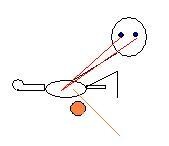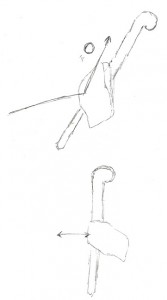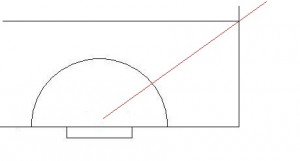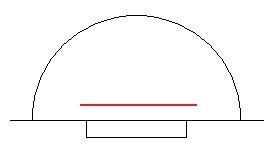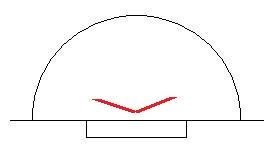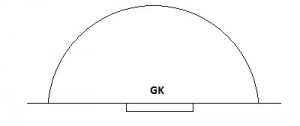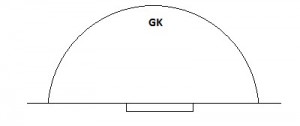Drag flicks are quite an important type of shot to face, with the speed and accuracy of elite masters of the art of drag flicking being a deadly thorn in the side of even the best goalkeepers. Greats like Taeke Taekema, Sohail Abbas and others on the international scene are reminders of how influential their talents are by scoring on the set play of a short corner through the specialist art of a well executed drag flick. However, that is not to say you should merely throw up your hands and accept defeat, saying great goal, if you want to really push your standards of goalkeeping! By learning to read the flick and how to react to it with quick reflex and athleticism, you can start to combat its deadliness, and make yourself more unbeatable.
What makes the drag flick so special?
The difference between a normal shot and a dragged ball is the way it reaches the net; a flick will push the ball up in a circular route, whereas a strike will knock the ball skyward along a raised diagonal line or a slap and hit across the floor of the pitch. With the drag flicker holding their stick far back behind the body and then pushing with force into the flick, the drive of the motion creates a massive momentum from which to raise the ball. The way the ball travels in this way makes it significantly harder for the goalkeeper to deal with, as it is harder to tell whether the ball will be pushed up really high into the upper echelons of the goal, or simply raised off the floor to make it difficult for the goalkeeper to stop it.
The direction is often unknown, especially if the drag flicker is able to hide their intentions; when disguised, or pushed out to the side off the shaft of the stick, forcing the goalkeeper to react more to the flick, rather than being able to have a better idea of where the ball is headed. The ability to analyse where the ball is headed is also made more difficult by some drag flickers’ abilities to disguise their intentions. With the shoulder in front shielding the ball’s intended path and unorthodox techniques like Ashley Jackson’s, the goalkeeper has a harder time dealing with a drag flick. Combined with the speed of a strongly pushed flick, it becomes a deadly weapon for the opposition. As a result, you must have good, quick reflexes to react for the save (with the speed of the flick requiring you to be just as speedy with your reaction times) and properly watch the flight path all the way through into the save; reading the flick well, in order to stop it.
Dealing with flicks
Whereas you can play the percentages against a straight strike and go into a barrier to cover more against a low struck hit, you aren’t able to control the chances when faced with a drag flick, instead you have to be more proactive with your reads and reactions. By using your upright stance to readily cover more of the goal and having to react to the flick rather than exposing more room, you can still challenge the flicker. Dealing with drag flicks is more of a case of reacting at the right time, staying patient until the time is right to use your reflexes or athleticism to make the save.
Reading the flick?
Working out where the ball is headed is more difficult when faced with a drag flick. Whereas it is easier to make an educated guess when facing a shot, the flick is more difficult to read. The important thing is not to over complicate things by guessing wrongly. By being aware of the opportunity to be scored on from any area, it is easier to combat the flick; moving into the save as the ball comes at you. With the drag flicker looking to expose available space, there is more of a chance of the flick going low where it is difficult to reach, or to the tops of the goal, in the corners. With an upright stance taking up more room, it is often easier to react from your standing position. If you like to make saves against flicks from a standing position, then raising your gloves to around the height of your shoulders, in front of you to react more easily as you push into the save, will help you react against a high flick around you and push into the save.
Focusing intently on the ball
Again, as I have written about before, focusing on the ball is incredibly important. From the injection to the save, you need to be totally focused; the more focused you are on the ball, the better chance you have of making the save as you are more set on its movements. Watching the ball is so important to making the save against a drag flick. If you try to see the ball at the last minute, then you won’t have a chance at stopping the ball. Make sure you start focusing on the ball from the moment the shooter receives the pass from the injection, right through to the save itself. You need to keep concentration and keep your eyes locked on the ball; by concentrating on the ball, you will be able to successfully move your glove or pad into the right place to block.
Athleticism
If you cannot reach the ball standing up or reach a low ball with your feet (although you may like to use the splits as an option to get to the ball, like Stockmann often does), then you are going to have to leave your foot to be able to make the save. The better your athleticism, the more readily you can deal with flicks acrobatically to make the save as you push out to reach high and wide (or low!) flicks. Diving high, wide, or low, improves your chances of getting behind the ball and turning it away.
Difficult flicks to deal with
Knowing that the goalkeeper should be good enough to stop most flicks, at the higher levels, the flicker will really look to expose your potential weaknesses. A flick straight down the middle of the goal and between the legs should be a good scoring opportunity, with a goal definite if the goalkeeper stumbles with their footwork and opens gaps for the ball to go through, and if not, a rebound scoring chance if the save is made. Flicks around the gloves that are difficult to reach if they are close to the body, with indecision and crossing over of hands are also a problem area for the goalkeeper.
The following clip shows examples of difficult flicks:
Leaving your feet too early
When trying to stop a drag flick, goalkeepers can be the victim of going down too early, expecting a low flick and end up being beaten by a high flick instead. By not guessing or leaving your feet before the flick arrives and reacting on time, rather than too early, the goalkeeper has a better chance of making the save and stopping the ball. Being patient but also ready to act instantly when the destination is clear, is important to making the save. If you are faced with a drag flick for the first time, there is a chance that you won’t know what to do and be more inclined to ‘log’ anyway, putting you out of the game of save making entirely!
Going the wrong way
When faced with a drag flick, there is also the problematic of going the wrong way and guessing which way the ball is headed, only as a result to be unable to reach the ball and end up conceding. The key to prevent this is again not to guess or try to predict where the ball will end up, but to react and focus on the ball’s flight, getting your timing right to be able to stop the incoming ball. Expecting the unexpected, instead of trying to second guess the situation, helps to prevent getting beaten!
The following goal scored by East Grinstead displays a goalkeeper going the wrong way, with the Bowdon goalkeeper going the wrong way and then consequently being unable to reach the flick as it goes in:
In the following clip, you can see Dan Vismaans going to the right rather than left against a well executed Bram Lomans drag flick at about 0:48 playing time:
Reacting at the right time
Being able to react on time is in itself an elite skill to have. It’s difficult to get a good read on flicks all the time, so being able to react to it as it approaches you is more important. Reacting appropriately is quite essential to being able to make the save. Not going too early and taking the bait of the drag flicker, in the sense that you may go the wrong, is essential. The better your reaction times and reflexes, the better you are being able to deal with fast drag flicks. Which is obviously why goalkeepers at the highest levels have remarkably fast reflexes, so it is no wonder why they are so quick, making last second saves, making use of their natural talents!
Patience
Staying upright and then reacting appropriately will help increase your chances of making the save. Whereas committing early can leave you looking silly, being patient and trusting your ability to react with your reflexes will obviously help you with potential problems of going too early. It’s something I’ve written about before and probably need to link to! The better your reflexes, the longer you may be able to leave it, theoretically, reacting at the last minute (figuratively!) to stop the ball as it finally reaches you.
Challenging
One way of proactively challenging the drag flicker, is to challenge with your positioning by having a higher ‘line’. Challenging the flick means you need to react quickly to it as it comes in, but forces your reflexes to do the work (theoretically!). I think by having to react you do not have time to over analyse or over think or get fooled into going the wrong way, being forced into going the direction of the ball as it comes in. ‘Quico’ Cortes (Spanish international, formerly at Egara and now Den Bosch), can be pretty good at this technique, challenging well and then reacting athletically to stop the flick. Not over challenging and not over doing will be better for you as it still gives you the chance to react.
At 2:34 playing time of this clip, you can see Cortes making an unbelievable stop against Zeller (one of the world’s best players) using a combination of proactive depth and athleticism:
Staying deep
Alternatively, you may prefer to have a lower ‘line’ and rely more on your athleticism instead of cutting the angles. A modern trend in facing short corners, discussed before, is to play very deep within the D. Staying deep is a new technique used by a lot of goalkeepers at the international and Hoofdklasse level. You will now see a lot of goalkeepers at the top level staying very deep within their D, in order to give them more time to react to an extremely fast drag flick. If you watch Vogels, Stockman, Veering, Jenniskens or Blaak, they all stay deep in their D when facing a drag flick on the corner. They stand literally a foot off the goal line once they have stepped out of goal on the corner. This is because it gives them an advantage of having extra time to react against the flick. By being deeper, they have slightly longer. In comparison, if they were to be much further out, then they would have less time to react. By being deep in their D, it gives them longer to react (even if a millisecond extra!) to the flick; giving them the chance to watch the flight of the ball and get a better ‘read’ on the flick to move into the save as they see the ball into their equipment.
However, this is at the risk of exposing and opening up more space to shoot into, as they are not challenging the angles. The cost of staying deep is at the disadvantage of giving more shooting space to look at, with the drag flicker able to see more of the goal. Whereas challenging angles and ‘playing big’ helps you cut down space, you are obviously exposing more space, leaving more room to flick into. So if you are going to play like this, you need to have good athleticism to extend into the save!
Practising
Brudtärna klänningar kan välja en enkel stil. Bästa alltid kommer från den klassiska, denna retro brudtärna är en dyrbar skatt. Fantastiska bilder kommer att dra oss tillbaka till Europa i början av seklet
Like any technique, it is good to practise facing drag flicks. The more you practise you get, the better you will be come game time as you will be confident in your ability to make the saves at short corners, whenever your team concedes them. Goalie coaches often use a lacrosse stick to copy the speed and accuracy of a drag flick. Obo’s training tool for drag flicks is useful because it can more easily replicate these qualities and is designed to make it harder to read, unlike the lacrosse stick. The best type of practise is to practise against the best! Training with good drag flickers is obviously going to help improve your ability to stop drag flicks. Try and find the best drag flicker in your club to train with, is an idea! Working on your reaction speeds and eye co-ordination in your spare time away from the pitch will also obviously be very useful in helping you when you have to face drag flicks.
Pointers:
- Stay on your feet for as long as possible, so that you don’t get wrong footed or go too early
- Like any type of shot, focus intently on the ball to get a good ‘read’
- Leave your feet and dive high or low as appropriate if you cannot reach it from a standing position
- Play according to your strengths; challenge or stay deep as you feel works for you, reacting with reflexes or athleticism according to your abilties
